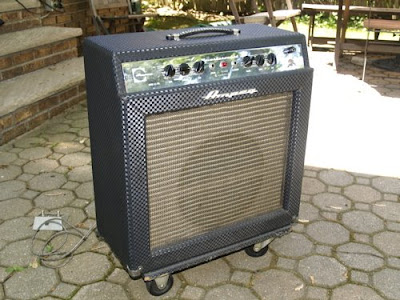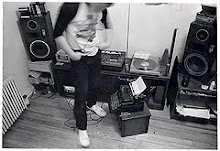 Student loan money, about a grand, bought me this in 1980.
Student loan money, about a grand, bought me this in 1980.
In response to a question on how to use the Tascam 144, I will attempt to activate a portion of my brain perhaps petrified. It has been been 30 plus years, but I used this thing till my fingers bled, so I bet I still remember.
WHAT-A-STUDIO? Back in the day (and still) a regular cassette tape played back in stereo, 2 channels, going in one direction.Then you'd flip it over and it played two more in the other direction. It had 4 distinct "tracks" to record audio, 2 in each direction.
Teac-Tascam had the brilliant idea to use this existing technology more creatively. By recording all four channels in one direction and playing them back simultaneously, you had a multi-track, four track capability on standard, available cassette tape. Doubling the speed of the tape, thus increasing fidelity, helped, and then they added noise reduction to reduce hiss. they put a really good transport system on it, that allowed you to punch in, or drop into a recording and start recording anew without the thump you usually get on consumer decks. A mixer was added to the recorder, and there you had it. A totally portable studio. A PORTASTUDIO.
CHANNEL STRIP- You have 4 channel strips with: micline/tape select button, trim knob, eq knobs, send knob, pan knob and a fader.
- The trim adjusts how sensitive the mic/line input (plug in the back) will be. Left least, right most sensitive.
- The micline/tape button selects which input will feed the channel strip – either mic/line source plugged into the back, or the audio already recorded on the corresponding tape track.
- Of course you have those beautiful old fashioned UV meters with the needles jumping around.
MASTER SECTION- A master fader that controls the level of all those first 4 combined in a stereo mix.
- Above it you have bus selector buttons to select which buss, left or right will record.
- Then the track selector buttons, to choose which track on each buss will record.
- Off turns recording, well, OFF.
- Andaux return knob adjust how much comes back to the master mix from the aux return input out back
- Monitor knob and buttons giving you choice of cue or mix to listen to via your phones.
CUE
- Then over on the right you have 4 more "cue" knobs. They will allow you to mix what's already on tape and listen to it as you overdub new tracks over already recorded ones, so you can play guitar along with the drum track you first recorded, and then add the bass... etc.
STEREO BUSS WHAT?
What the #$%$# is that, you ask. Basically you can record one or two tracks at once, over a stereo buss, aiming your audio left or right with the pan knobs on each channel strip. The little buttons over the master fader choose which buss you want to record onto, left or right. Don't be confused into thinking what you record left, stays left. It doesn't. It just sends it to a certain part of the tape. You can pan every channel to where you want in your final mix.
Below that, the track selector buttons for which track will record. Or if you want to turn recording off on that buss. You can record one left and one right track, 2 at a time... it is a stereo buss, after all. So it's 1 or 3 and 2 or 4.
So say you pushed in the 1 button and on the other buss, the 4. You would then be recording tracks 1 and 4 at the same time. Whatever sound source you have plugged into your track inputs 1-4, will go to either left, to track 1 or right, to track 4, depending how you have the pan knobs set on those input channels. Panned hard left you are recording to track 1, hard right to 4 and in the middle to both. So you can put in 4 mics for four singers in to inputs 1, 2, 3, 4 and pan the mics all over the stereo field and get a stereo spread, or pan some hard right and others hard left to record them specifically on only 1 or 4. Get it?
DO IT
Plug a sound source, say a mic, into the back, input 1. Pan hard left on the channel's pan knob. Plug another into input 2 or 3 or 4, it doesn't matter, and pan hard right. The first will record on track 1, the second on track 4. Make sure the push button at the top of the row is set to "mic/line." That sets the input directed down that channel strip. If set to "tape" you'd be using the recorded track as your source material, and re-recording it to another track. That's how you "bounce" tracks down, combining perhaps 3 tracks to one, to open those first three up for more audio.
Hit pause and record. (or was it pause and play
and record at the same time?) Tape is not rolling yet. Remember, the trim knob at the top of the channel strip controls how sensitive the input will be. Start dialed all the way left and work clockwise until you have a UV meter level just peaking before the red zone.
RECORD
Start recording and go for a while. Now rewind, flick those channel selector buttons over to 2 and 3, dial up cue knobs 1 and 4, and do it all over again. You are hearing your first take on 1 and 4 and recording 2 new takes on 2 and 3. Bingo. Your tracks are full.
YOUNG AND BOUNCYThis where the beauty of "bouncing comes in." You can combine, or bounce tracks together along with more live audio, if you like, to another track(s). The same way those Beatles did Sgt. Pepper... It's only 4 tracks, but by bouncing them together and opening up the original tracks for more music, you can create layers and layers and layers.
BACK UP A BIT
So wait. Don't fill up your tracks like I just said. Try something like this: record a drum track on 1, then a bass on 2, then a guitar on 3. Rewind. Then push in the micline/tape selector to "tape" on channels 1, 2 and 3 and pan those hard right. Push the record selector button 4 into record. Plug a mic and a tamborine into input 4, with the micline button on mic/line. pan hard right too. Hit play to adjust the mix as you combine drums guitar bass and live tamborine to 4. Levels look good? Not too much in the red? Rewind and hit record.
Now you should have everything (ok it's mono) on track 4. Go back and record backup vocals on 1 and harmony on 2. Then bounce them over to 3 as you add another vocal. Now you can record a lead guitar on one, bounce that over to 2 as you add a synth. Then go back and record your lead vocal on 1. You have drums, bass, guitar, guitar on 4, 3 vocals on 3, guitar and synth on2 and vocal on 1. Ten tracks, and you only bounced things once at most, so they sound pretty good still. It does deteriorate with every generation.
It really makes you think and train your ears when you have to commit to a bounce and plan all this stuff.
HAVE SOME PUNCHMind you the Tascam can punch in too. You sang a flat note? Just hit record on the fly and it cuts right in seamlessly. Very cool. You can use the aux send to send tracks or live inputs to effects devices and return them to the effects return. Or return them back into another channel strip. Explore the inputs on the back.
SSlowww mO
Don't ignore the varispeed knob. You can slow down the tape and sing. Speed up and be a chipmunk. Or go the other way and Turn a guitar into a bass. Song sluggish? Crank the speed up a tiny tad for that extra surge or energy.
?
Ok, so that was pretty confusing, but once you get the hang of this thing it's very intuitive. Loads of fun too.
Your "new" portastudio is actually very old though. So expect drive belts to break, and what not. There are lots of forums online where people can help you fix these machines. I used a dime store rubber band for once about 3 months. It held pretty well.
NOSTALGIC PURCHASE TIMENow excuse me, I feel drawn to prowl ebay for a deal on one of these...
 The JV-1010 is like Las Vegas. Lots of sparkle and polish, affordable to get there, but my short vacation with this unit is ending. (I got this 1999 half-rack at a used music store for $175 a few months ago [2008]).
The JV-1010 is like Las Vegas. Lots of sparkle and polish, affordable to get there, but my short vacation with this unit is ending. (I got this 1999 half-rack at a used music store for $175 a few months ago [2008]).




















